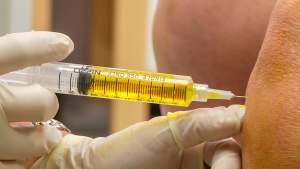Indiscriminate bans could lead to patients being left with no options for their pain.

Source: Amaregenmed, Injection knee ama regenerative medicine, 2018. 1,920 × 1,080 (1.07 MB). https://commons.wikimedia.org/wiki/File:Injection-knee-ama-regenerative-medicine.jpg#file (accessed September 23, 2019).
In May 2019, over three dozen clinics across British Columbia, Alberta, Ontario, and Quebec were ordered by Health Canada to cease and desist offering unapproved stem cell therapies. While this may seem like a reasonable regulation to prevent untested medical treatments being used on unsuspecting patients, many clinics, like Toronto PRP and Stem Cell, say that this ban is too broad and denies patients access to well-documented successful treatments.

The above video by the DISC Spine Institute – Dallas explains what adult stem cells are and how they can be harnessed for stem cell therapies.
Adult stem cell therapies have been shown in multiple studies to be effective for joint, ligament, and tendon injuries, such as osteoarthritis. Additionally, many patients who have undergone these “unapproved” stem cell therapies have noticed greater range of motion, less pain, and more functional abilities. With the new regulations, all similar treatments, except for certain blood cancers, such as leukemia and lymphoma, would only be available to a select few patients through clinical trials.
This ban does not come without good cause, however. Many private clinics have been advertising stem cell therapies as the ultimate panacea, offering it as a treatment for autism, multiple sclerosis (MS), ALS, and even hair-loss, when there have been no studies to prove their effectiveness in these conditions. Additionally, the nature of these therapies, while leading to long-term improvements, could also lead to long-term threats for those seeking these treatments. Health Canada states that many risks, such as infection by bacteria and viruses, patient cross-contamination, and even tumour formation, have been observed in unapproved stem cell therapies.
There is also a more sinister aspect to these unproven medications. Due to the thousands of dollars each stem cell therapy costs, there is a high risk of financial exploitation. Many private clinics who are capitalizing on the clout of a cure-all miracle drug are using stem cells for absolutely untested treatments, and gaining up to $15 000 per treatment. These sorts of advertisements depend upon the desperation of the sick and disabled and their families to make their living, and most doctors agree it has to stop.
At the end of the day, many believe that Health Canada had to do something about the unregulated use of stem cell therapies across Canada. However, there is also worry that those desperate enough to pay the high fees for these treatments would be willing to go to less safe clinics outside of Canada to undergo these treatments anyways. By slowly implementing restrictions, instead of this broad ban, Health Canada could have avoided this issue, as well as prevented the denial of viable treatments to patients in need.
Written by Kaitlyn Le







